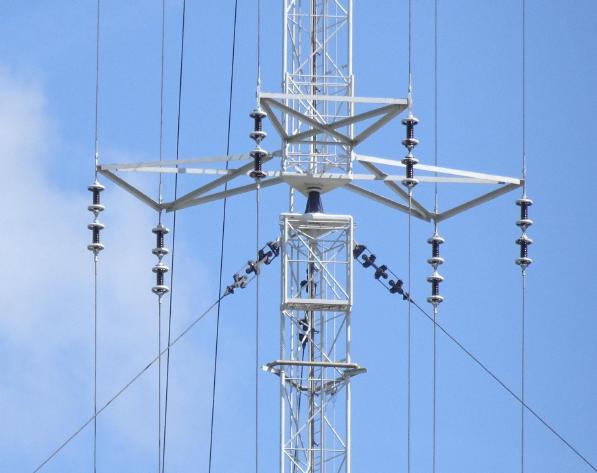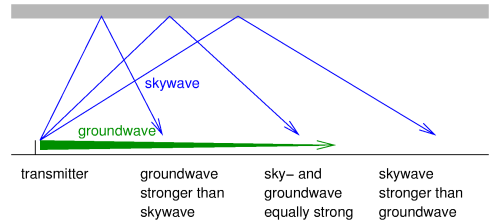1008 kHz QRT
Pieter-Tjerk de Boer, PA3FWM web@pa3fwm.nl(This is an adapted version of part of an article I wrote for the Dutch amateur radio magazine Electron, May 2019.)
On January 1st, 2019, the transmission of Groot Nieuws Radio via the mediumwave transmitter on 1008 kHz in the Flevopolder has been stopped. The transmitter itself stayed on the air for another three days with a repeating announcement to direct listeners to other means of reception, but was switched off after that, and a week later the masts were torn down. With that, the last big mediumwave transmitter in the Netherlands has left the airwaves. Also in surrounding countries most mediumwave transmitters have been shutdown in recent years, so during daytime one doesn't hear much here anymore: some signals from England, and depending on one's location some low-power transmitters (up to 100 W) with limited range. In the evening and night time, there still is a lot to be heard.
 I already wrote earlier about the rather special transmit antenna that has been gracing
the Flevopolder since 1980 [8].
The adjacent figure shows a detail of this antenna: the feedpoint, 90 m above ground.
We see two pieces of pylon mast with an isolator in between, the black cone.
Around the pylon mast, there are six wires which are the actual radiator,
and which are also interrupted by isolators at this height.
Furthermore, less visible, there is a climbing ladder in the center of the mast for maintenance.
However, that ladder also constitutes, together with the surrounding pylon mast,
a coaxial cable supplying the transmit power from the bottom of the mast.
The center conductor of this coax, i.e., the ladder, is connected to the top pylon mast
via a connection inside the isolator.
See [8] for more details.
On the Omroep Flevoland website, one can see that while tearing down the masts,
they bent at the position of the isolator [1].
I already wrote earlier about the rather special transmit antenna that has been gracing
the Flevopolder since 1980 [8].
The adjacent figure shows a detail of this antenna: the feedpoint, 90 m above ground.
We see two pieces of pylon mast with an isolator in between, the black cone.
Around the pylon mast, there are six wires which are the actual radiator,
and which are also interrupted by isolators at this height.
Furthermore, less visible, there is a climbing ladder in the center of the mast for maintenance.
However, that ladder also constitutes, together with the surrounding pylon mast,
a coaxial cable supplying the transmit power from the bottom of the mast.
The center conductor of this coax, i.e., the ladder, is connected to the top pylon mast
via a connection inside the isolator.
See [8] for more details.
On the Omroep Flevoland website, one can see that while tearing down the masts,
they bent at the position of the isolator [1].
From a historical point of view, it is funny that precisely the 1008 kHz remained in use longest, and that the user of this frequency in fact would have liked to continue using it. In the early days, radio technicians in the Netherlands weren't so happy with this frequency, because they considered it unusable. In the weekly magazine Radio-Express, in 1929 Jan Corver even wrote a three-part series with the telling title "What should the Netherlands do with the 298 m wave?" [2]
What was the matter? Until 1929 the Dutch broadcast transmitters used longwave frequencies of 160 and 280 kHz. At the 1929 European radio conference in Prague, the Netherlands lost 280 kHz, because it was outside the broadcast bands, and was assigned 1004 kHz instead. The disadvantage of this higher frequency is that the ground wave is attenuated with distance much more rapidly than at the lower frequency. As a first consequence, a much larger transmit power is needed to cover all of the Netherlands with a single transmitter. But there is a second, more fundamental problem.
 After sunset, the skywave (reflection via the ionosphere) also plays a role.
At short distance from the transmitter, the groundwave is stronger than the skywave,
but farther away the groundwave becomes progressively weaker while the skywave stays
approximately equally strong (as it already makes a huge detour via the ionosphere).
Thus we see that farther away from the transmitter, the skywave dominates,
but in between there is an area where both are approximately equally strong.
In that area, they can cancel each other if they happen to be in opposite phase,
which gives a very annoying distortion.
See the figure.
At a higher frequency, the groundwave strength reduces more quickly, so the area where
groundwave and skywave are approximately equally strong, moves closer to the transmitter.
Thus, the area of undisturbed reception is smaller at higher frequency;
at 1004 kHz this area is already smaller than the size of the Netherlands.
Using more power does not solve this, because it makes both groundwave and skywave
stronger by the same amount.
So, at such a frequency it is impossible to give clear reception in all of the Netherlands!
After sunset, the skywave (reflection via the ionosphere) also plays a role.
At short distance from the transmitter, the groundwave is stronger than the skywave,
but farther away the groundwave becomes progressively weaker while the skywave stays
approximately equally strong (as it already makes a huge detour via the ionosphere).
Thus we see that farther away from the transmitter, the skywave dominates,
but in between there is an area where both are approximately equally strong.
In that area, they can cancel each other if they happen to be in opposite phase,
which gives a very annoying distortion.
See the figure.
At a higher frequency, the groundwave strength reduces more quickly, so the area where
groundwave and skywave are approximately equally strong, moves closer to the transmitter.
Thus, the area of undisturbed reception is smaller at higher frequency;
at 1004 kHz this area is already smaller than the size of the Netherlands.
Using more power does not solve this, because it makes both groundwave and skywave
stronger by the same amount.
So, at such a frequency it is impossible to give clear reception in all of the Netherlands!
In his articles, Corver therefore argues that we should not use a single big transmitter on this frequency, but a number of smaller, synchronised transmitters spread out over the country. But in the end, this didn't happen.
That the transmitter in the Flevopolder can in fact cover almost all of the Netherlands, is due to the use of a so-called anti-fading antenna: an antenna which has a null at elevations of about 45 degrees. In the figure, this effectively cancels the middle one of the three skywaves shown. As a consequence, precisely in the critical area where the skywave would be equally strong as the groundwave, the skywave is suppressed so the groundwave can still be received undisturbed there. The area with bad reception due to interference of groundwave and skywave is "pushed" farther out, to beyond the country borders.
References:
[1] https://www.omroepflevoland.nl/nieuws/167123/live-zendmasten-worden-opgeblazen
[2] J. Corver: Wat moet Nederland met de 298 m. golf aanvangen? Radio-Express 18 oct., 25 oct. en 1 nov. 1929.
[8] Technische notities van PA3FWM, Electron 12/2015; online here.